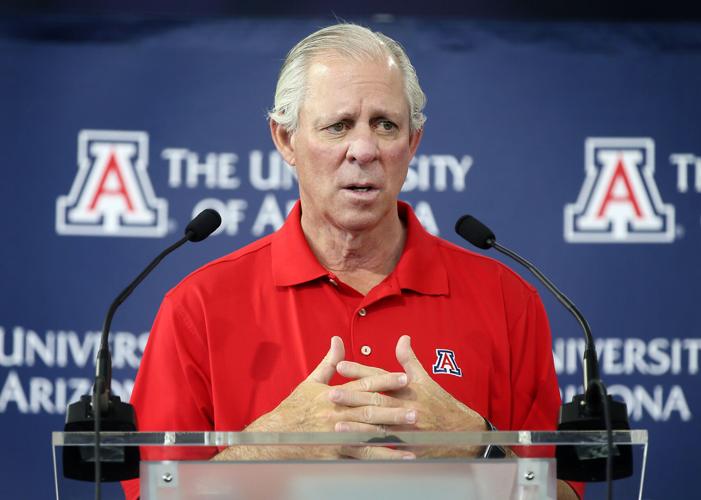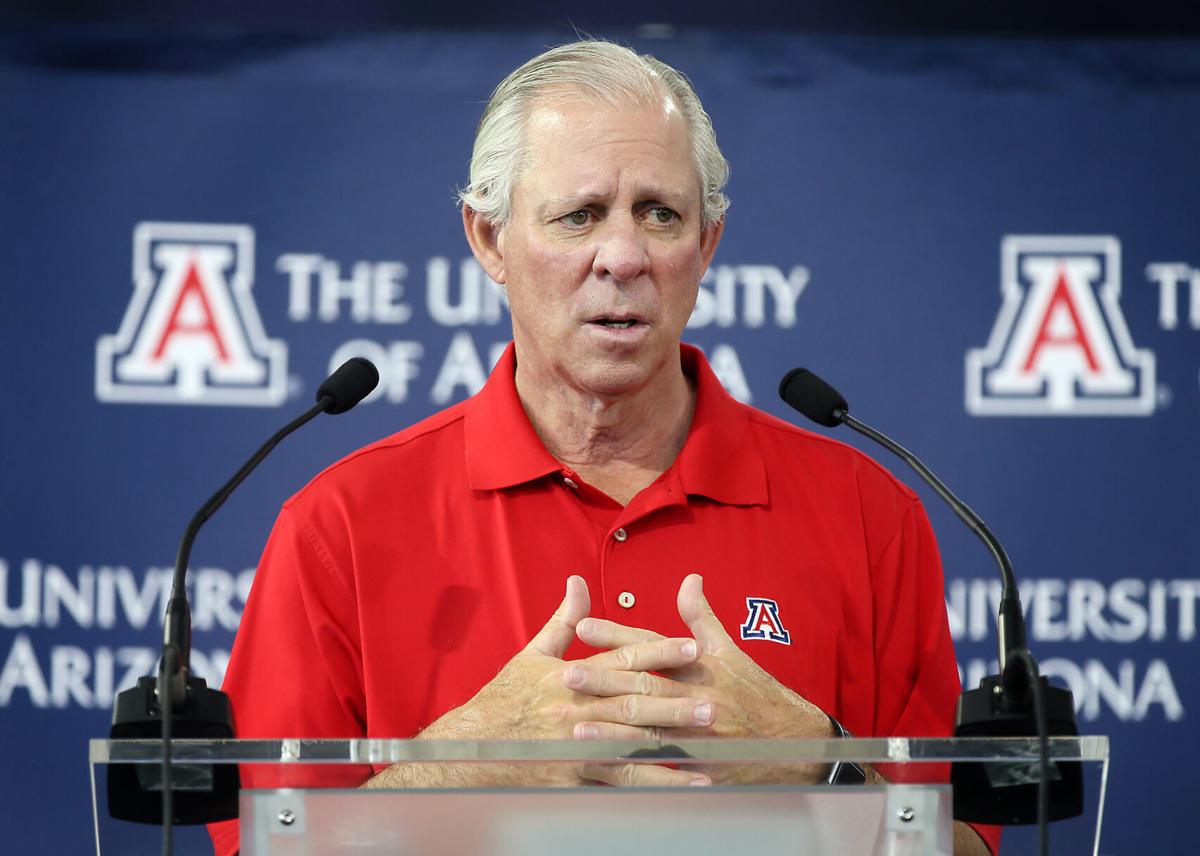The Pac-12 is staggering, the Big 12 is circling and one school currently sits in the crosshairs. Will Arizona be the next defection?
The conference’s future hangs in the balance as the media rights contract negotiations approach their 14th month and commissioner George Kliavkoff scrambles to hold the conference together.
The Los Angeles schools left last summer.
Colorado left last week.
Will Arizona follow the Buffaloes out the door?
And if the Wildcats leave their home of the past 45 years, then what? Could that trigger departures by Arizona State and Utah? Would Washington and Oregon begrudgingly accept offers — any offers — from the Big Ten? Would Stanford and Cal do the same? Where would that leave Washington State and Oregon State?
Resolution should come soon, with Kliavkoff expected to present a media rights deal to the anxious presidents as early as this week.
At the center of the storm resides Arizona president Robert Robbins, who has stated repeatedly — both in public and private — that he will wait for Kliavkoff to present a media deal for approval before deciding whether to haul his university into the Big 12.
Colorado chancellor Phil DiStefano didn’t wait. The Buffaloes became frustrated and accepted an invitation from the Big 12, their former home, last week.
What will Robbins do?
Welcome to the Hotline’s 2023 Pac-12 Presidential Power Index. Our ranking of the nine remaining university leaders is based on a slew of factors, including each president’s role in the media rights and expansion decisions.
1. Arizona’s Robert Robbins
The clear pick for No. 1 at the moment. In addition to his vital role in Arizona’s future, Robbins just began a term on the Pac-12 board’s three-person executive committee, which helps set the agenda and drive strategic decisions. What’s more, he’s well-versed in college athletics and has been one of the few presidents willing to offer public comments on the media rights saga, thereby enhancing his leadership role. That said, we can’t help but wonder about Robbins’ future in Tucson. After all, Stanford is searching for a new president, and Robbins seemingly would be an ideal candidate: He did his residency at the school and later became a department chair (cardiothoracic surgery). Could the situation play any role in his decision-making process with regard to Arizona’s conference affiliation? It seems highly unlikely — Stanford’s search will take months — but at the purely theoretical level, it’s a layer of intrigue we feel obliged to mention.
2. Washington State’s Kirk Schulz
Schulz was elevated to chair of the Pac-12’s executive committee this summer and thus holds significant sway over the agenda and discussions. Also, he’s well-respected by other board members for his knowledge of college sports and connections across the country. (Schulz is the conference’s representative on the College Football Playoff’s board of managers and played a role in the presidents’ push to expand the event after the commissioners reached a stalemate.) If the Cougars held a more influential role in the realignment game, Schulz would be No. 1.
3. Utah’s Taylor Randall
In his two years since taking charge of the university, Randall’s role on the Pac-12 board has grown considerably. In fact, we believe he will join Robbins and Schulz on the executive committee at the end of this month, replacing Stanford’s Marc Tessier-Lavigne. (Committee appointments are based on seniority and prior participation.) Randall values the impact college football carries on campus and in that regard is a rarity in the conference. Although Utah sits on the Pac-12’s fault line with Arizona and ASU, we do not expect the Utes to be a prime mover. They appear committed to the conference unless that isn’t a viable option.
4. Arizona State’s Michael Crow
The longest-serving member of the Pac-12 board — he took charge of ASU in 2002 — has seen his influence ebb and flow over the years. He was instrumental in hiring Larry Scott and the staunchest supporter of Scott’s misguided policies, which eventually undercut Crow’s clout. But our sense is that Crow has experienced a boardroom renaissance of sorts, in part because so many of his peers are either new to their roles or on their way out. And there’s a scenario in which Crow ends up deciding the fate of the conference. If Arizona leaves for the Big 12, would ASU follow ... or stop the bleeding?

ASU President Michael Crow is the longest serving member of the Pac-12's board — and may hold the fate of the conference in his hands.
5. Oregon’s John Karl Scholz
The newest member of the board, Scholz has been on the job in Eugene since July 1. As a result, we have little insight into his management style, relationship with Phil Knight or role on the Pac-12’s board. However, Oregon’s leadership position within the conference is such that any permanent president, regardless of name or experience, carries significant influence.
6. Washington’s Ana Mari Cauce
A year ago, Cauce was No. 3 on our list due to UW’s position as a potential Big Ten target and Cauce’s role as chair of the Pac-12 board. Her term as chair expired this summer, and she’s no longer on the executive committee. From our corner of the galaxy, Cauce’s performance at the top of the org chart was disappointing, just as her public position in the media rights process was conspicuous by its complete and utter absence.

Washington's President Ana Mari Cauce has slipped three spots in the Hotline's rankings over the past year.
7. Oregon State’s Jayathi Murthy
Another new face on the board, although not as new as her colleague down the road in Eugene. Murthy’s tenure began last fall, when the conference was deep into its existential crisis. By all accounts, she developed an appreciation for college sports during her years on the UCLA faculty, but we cannot vouch for her understanding of major college football and the dynamics that govern the sport. And much like WSU, Oregon State has a limited role in realignment.
8. Cal’s Carol Christ
If Cal’s immense struggles on the field and the court, its disappearance from the West Coast sports scene and its immaterial role in realignment were not enough to position Christ on the board’s bottom tier, there’s this matter: She is retiring next summer. To what extent will she drive or sway the media rights process and a decision on expansion? Our expectations are low.
9. Stanford’s Marc-Tessier Lavigne
Congrats to Tessier-Lavigne for the race to the bottom of the presidential power index — a victory fueled by Stanford’s limited role in the realignment game and Tessier-Lavigne’s own future. He’s stepping down as university president at the end of August following an academic scandal. We expect his position on the executive committee to be filled by Utah’s Randall, although the conference has not confirmed that swap.
Arizona football coach Jedd Fisch discusses what stability, including with the return of second-year defensive coordinator Johnny Nansen, means to his Wildcats ahead of the 2023 season. Fisch spoke at Pac-12 media day in Las Vegas on July 21, 2023. Video courtesy Pac-12







